A Comprehensive Assessment of the Hydrological Evolution and Habitat Quality of the Xiangjiang River Basin
Abstract
:1. Introduction
2. Study Area and Data
2.1. Study Area Overview
2.2. Data Source and Processing
3. Methodology
3.1. Hydrological Variability Determination
3.1.1. Sliding t-Test
3.1.2. Cumulative Anomaly Test
3.2. The Most Ecologically Relevant Hydrological Indicators
3.2.1. The Indicators of Hydrologic Alteration
3.2.2. The Environmental Flow Components
3.2.3. Principal Components Analysis
3.3. The Long Short-Term Memory Model
3.3.1. Model Structure
3.3.2. Model Parameters
3.3.3. Separation Framework
3.4. The Integrated Valuation of Ecosystem Services and Tradeoffs Model
3.5. Grey Correlation Theory
3.6. Shannon Index
4. Results
4.1. Trend and Mutation Analysis
4.2. The Most Ecologically Relevant Hydrological Indicators
4.2.1. Correlation Analysis of Indicators and Selection of ERHIs
4.2.2. Inter-Annual Variation in ERHIs Indicators
4.3. Ecohydrological Situation, Environmental Flow Evolution, and Quantitative Attribution
4.4. Habitat Quality Assessment and Its Response to Hydrological Change
4.5. Riverine Biological Conditions
5. Discussion
6. Conclusions
Author Contributions
Funding
Data Availability Statement
Conflicts of Interest
Appendix A. Correlation of Hydrological Parameters
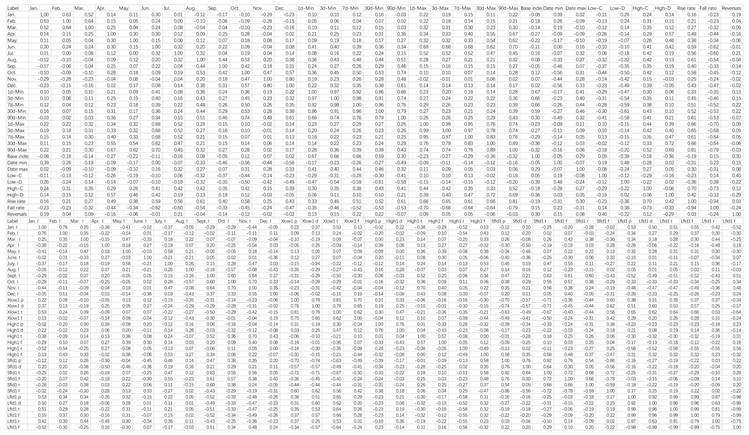
References
- Karr, J.R. Defining and measuring river health. Freshw. Biol. 1999, 41, 221–234. [Google Scholar] [CrossRef]
- Zhou, T. New physical science behind climate change: What does IPCC AR6 tell us? The Innovation 2021, 2, 100173. [Google Scholar] [CrossRef] [PubMed]
- Myhre, G.; Alterskjær, K.; Stjern, C.W.; Hodnebrog, Ø.; Marelle, L.; Samset, B.H.; Sillmann, J.; Schaller, N.; Fischer, E.; Schulz, M.; et al. Frequency of extreme precipitation increases extensively with event rareness under global warming. Sci. Rep. 2019, 9, 16063. [Google Scholar] [CrossRef] [PubMed]
- Grill, G.; Lehner, B.; Thieme, M.; Geenen, B.; Tickner, D.; Antonelli, F.; Babu, S.; Borrelli, P.; Cheng, L.; Crochetiere, H.; et al. Mapping the world’s free-flowing rivers. Nature 2019, 569, 215–221. [Google Scholar] [CrossRef]
- Zhao, H.; He, J.; Liu, D.; Han, Y.; Zhou, Z.; Niu, J. Incorporating ecological connectivity into ecological functional zoning: A case study in the middle reaches of Yangtze River urban agglomeration. Ecol. Inform. 2023, 75, 102098. [Google Scholar] [CrossRef]
- Richter, B.D.; Baumgartner, J.V.; Powell, J.; Braun, D.P. A method for assessing hydrologic alteration within ecosystems. Conserv. Biol. 1996, 10, 1163–1174. [Google Scholar] [CrossRef]
- Song, X.; Zhuang, Y.; Wang, X.; Li, E.; Zhang, Y.; Lu, X.; Yang, J.; Liu, X. Analysis of hydrologic regime changes caused by dams in China. J. Hydrol. Eng. 2020, 25, 05020003. [Google Scholar] [CrossRef]
- Gao, W.; Hu, K.; Gu, Q.; Ling, X.; Ruan, M.; Ren, R. Survey of Fish Resources in Hengyang and Changzhutan Sections of the Main Stream of Xiangjiang River and Measures for Conservation. Low Carbon World 2019, 9, 14–16. [Google Scholar]
- Richter, B.D.; Warner, A.T.; Meyer, J.L.; Lutz, K. A collaborative and adaptive process for developing environmental flow recommendations. River Res. Appl. 2006, 22, 297–318. [Google Scholar] [CrossRef]
- Gunawardana, S.K.; Shrestha, S.; Mohanasundaram, S.; Salin, K.S.; Piman, T. Multiple drivers of hydrological alteration in the transboundary Srepok River Basin of the Lower Mekong Region. J. Environ. Manag. 2021, 278, 111524. [Google Scholar] [CrossRef]
- Olden, J.D.; Poff, N.L. Redundancy and the choice of hydrologic indices for characterizing streamflow regimes. River Res. Appl. 2003, 19, 101–121. [Google Scholar] [CrossRef]
- Smakhtin, V.U.; Shilpakar, R.L.; Hughes, D.A. Hydrology-based assessment of environmental flows: An example from Nepal. Hydrol. Sci. J. 2006, 51, 207–222. [Google Scholar] [CrossRef]
- Cheng, J.; Xu, L.; Jiang, J. Optimal selection of the most ecologically relevant hydrologic indicators and its application for environmental flow calculation in Lake Dongting. J. Lake Sci. 2018, 30, 1235–1245. [Google Scholar]
- Jiang, S.; Zhou, L.; Ren, L.; Wang, M.; Xu, C.; Yuan, F.; Liu, Y.; Yang, X.; Ding, Y. Development of a comprehensive framework for quantifying the impacts of climate change and human activities on river hydrological health variation. J. Hydrol. 2021, 600, 126566. [Google Scholar] [CrossRef]
- Arsenault, R.; Martel, J.L.; Brunet, F.; Brissette, F.; Mai, J. Continuous streamflow prediction in ungauged basins: Long Short-Term Memory Neural Networks clearly outperform hydrological models. Hydrol. Earth Syst. Sci. Discuss. 2022, 2022, 1–29. [Google Scholar] [CrossRef]
- Hu, C.; Wu, Q.; Li, H.; Jiang, S.; Li, N.; Lou, Z. Deep learning with a long short-term memory networks approach for rainfall-runoff simulation. Water 2018, 10, 1543. [Google Scholar] [CrossRef]
- Bai, P.; Liu, X.; Xie, J. Simulating runoff under changing climatic conditions: A comparison of the long short-term memory network with two conceptual hydrologic models. J. Hydrol. 2021, 592, 125779. [Google Scholar] [CrossRef]
- Fan, H.; He, H.; Xu, L.; Zhang, M.; Jiang, J. Simulation and attribution analysis based on the long-short-term-memory network for detecting the dominant cause of runoff variation in the Lake Poyang Basin. J. Lake Sci. 2021, 33, 866–878. [Google Scholar]
- Cao, Y.; Xu, L.; Fan, H.; Mao, Z.; Cheng, J.; Wang, D.; Wu, Y. Impact of climate and human activities on the changes of ecological flow indicators in the Lake Poyang Basin since 1960s. J. Lake Sci. 2022, 34, 232–246. [Google Scholar]
- Sharma, A.; Baruah, A.; Mangukiya, N.; Hinge, G.; Bharali, B. Evaluation of Gangetic dolphin habitat suitability under hydroclimatic changes using a coupled hydrological-hydrodynamic approach. Ecol. Inform. 2022, 69, 101639. [Google Scholar] [CrossRef]
- Nagendra, H.; Lucas, R.; Honrado, J.P.; Jongman, R.H.; Tarantino, C.; Adamo, M.; Mairota, P. Remote sensing for conservation monitoring: Assessing protected areas, habitat extent, habitat condition, species diversity, and threats. Ecol. Indic. 2013, 33, 45–59. [Google Scholar] [CrossRef]
- Zhang, X.; Zhou, J.; Li, M. Analysis on spatial and temporal changes of regional habitat quality based on the spatial pattern reconstruction of land use. Acta Geogr. Sin. 2020, 75, 160–178. [Google Scholar]
- Zhang, H.; Li, S.; Liu, Y.; Xu, M. Assessment of the Habitat Quality of Offshore Area in Tongzhou Bay, China: Using Benthic Habitat Suitability and the InVEST Model. Water 2022, 14, 1574. [Google Scholar] [CrossRef]
- de Mello, K.; Taniwaki, R.H.; de Paula, F.R.; Valente, R.A.; Randhir, T.O.; Macedo, D.R.; Leal, C.G.; Rodrigues, C.B.; Hughes, R.M. Multiscale land use impacts on water quality: Assessment, planning, and future perspectives in Brazil. J. Environ. Manag. 2020, 270, 110879. [Google Scholar] [CrossRef]
- Zeng, C.; Wen, Y.; Liu, X.; Yu, J.; Jin, B.; Li, D. Impact of anthropogenic activities on changes of ichthyofauna in the middle and lower Xiang River. Aquac. Fish. 2022, 7, 693–702. [Google Scholar] [CrossRef]
- Wang, H.; Ma, Y.; Hong, F.; Yang, H.; Huang, L.; Jiao, X.; Guo, W. Evolution of Water–Sediment Situation and Attribution Analysis in the Upper Yangtze River, China. Water 2023, 15, 574. [Google Scholar] [CrossRef]
- Djaman, K.; O’Neill, M.; Diop, L.; Bodian, A.; Allen, S.; Koudahe, K.; Lombard, K. Evaluation of the Penman-Monteith and other 34 reference evapotranspiration equations under limited data in a semiarid dry climate. Theor. Appl. Climatol. 2019, 137, 729–743. [Google Scholar] [CrossRef]
- Faisal, N.; Gaffar, A. Development of Pakistan’s new area weighted rainfall using Thiessen polygon method. Pak. J. Meteorol. 2012, 9, 1–10. [Google Scholar]
- Hou, L.; Zhu, J.; Kwok, J.; Gao, F.; Qin, T.; Liu, T.Y. Normalization helps training of quantized lstm. Adv. Neural Inf. Process. Syst. 2019, 32, 1–11. [Google Scholar]
- Hamed, K.H.; Rao, A.R. A modified Mann-Kendall trend test for autocorrelated data. J. Hydrol. 1998, 204, 182–196. [Google Scholar] [CrossRef]
- Hu, J.; Ma, J.; Nie, C.; Xue, L.; Zhang, Y.; Ni, F.; Deng, Y.; Liu, J.; Zhou, D.; Li, L.; et al. Attribution Analysis of Runoff change in Min-tuo River Basin based on SWAT model simulations, china. Sci. Rep. 2020, 10, 2900. [Google Scholar] [CrossRef] [PubMed]
- Richter, B.; Baumgartner, J.; Wigington, R.; Braun, D. How much water does a river need? Freshw. Biol. 1997, 37, 231–249. [Google Scholar] [CrossRef]
- Wang, H.; Huang, L.; Guo, W.; Zhu, Y.; Yang, H.; Jiao, X.; Zhou, H. Evaluation of ecohydrological regime and its driving forces in the Dongting Lake, China. J. Hydrol. Reg. Stud. 2022, 41, 101067. [Google Scholar] [CrossRef]
- Olsen, R.L.; Chappell, R.W.; Loftis, J.C. Water quality sample collection, data treatment and results presentation for principal components analysis–literature review and Illinois River watershed case study. Water Res. 2012, 46, 3110–3122. [Google Scholar] [CrossRef]
- Kühnert, C.; Gonuguntla, N.M.; Krieg, H.; Nowak, D.; Thomas, J.A. Application of LSTM networks for water demand prediction in optimal pump control. Water 2021, 13, 644. [Google Scholar] [CrossRef]
- Gauch, M.; Kratzert, F.; Klotz, D.; Nearing, G.; Lin, J.; Hochreiter, S. Rainfall–runoff prediction at multiple timescales with a single Long Short-Term Memory network. Hydrol. Earth Syst. Sci. 2021, 25, 2045–2062. [Google Scholar] [CrossRef]
- Yin, H.; Wang, F.; Zhang, X.; Zhang, Y.; Chen, J.; Xia, R.; Jin, J. Rainfall-runoff modeling using long short-term memory based step-sequence framework. J. Hydrol. 2022, 610, 127901. [Google Scholar] [CrossRef]
- Ahn, K.H.; Merwade, V. Quantifying the relative impact of climate and human activities on streamflow. J. Hydrol. 2014, 515, 257–266. [Google Scholar] [CrossRef]
- Xu, H.; Dong, B.; Gao, X.; Xu, Z.; Ren, C.; Fang, L.; Wei, Z.; Liu, X.; Lu, Z. Habitat quality assessment of wintering migratory birds in Poyang Lake National Nature Reserve based on InVEST model. Environ. Sci. Pollut. Res. 2023, 30, 28847–28862. [Google Scholar] [CrossRef]
- Gao, C.L.; Li, S.C.; Wang, J.; Li, L.P.; Lin, P. The risk assessment of tunnels based on grey correlation and entropy weight method. Geotech. Geol. Eng. 2018, 36, 1621–1631. [Google Scholar] [CrossRef]
- Yang, Y.C.E.; Cai, X.; Herricks, E.E. Identification of hydrologic indicators related to fish diversity and abundance: A data mining approach for fish community analysis. Water Resour. Res. 2008, 44, 4. [Google Scholar] [CrossRef]
- Yang, H.; Shen, L.; He, Y.; Tian, H.; Gao, L.; Wu, J.; Mei, Z.; Wei, N.; Wang, L.; Zhu, T.; et al. Status of aquatic organisms resources and their environments in Yangtze river system (2017–2021). Aquac. Fish. 2023. [Google Scholar] [CrossRef]
- Jia, Y.; Wang, L.; Li, S.; Cao, J.; Yang, Z. Species-specific bioaccumulation and correlated health risk of arsenic compounds in freshwater fish from a typical mine-impacted river. Sci. Total Environ. 2018, 625, 600–607. [Google Scholar] [CrossRef] [PubMed]
- Sofi, M.S.; Bhat, S.U.; Rashid, I.; Kuniyal, J.C. The natural flow regime: A master variable for maintaining river ecosystem health. Ecohydrology 2020, 13, e2247. [Google Scholar] [CrossRef]
- Comte, L.; Olden, J.D.; Tedesco, P.A.; Ruhi, A.; Giam, X. Climate and land-use changes interact to drive long-term reorganization of riverine fish communities globally. Proc. Natl. Acad. Sci. USA 2021, 118, e2011639118. [Google Scholar] [CrossRef]
- Palmer, M.; Ruhi, A. Linkages between flow regime, biota, and ecosystem processes: Implications for river restoration. Science 2019, 365, eaaw2087. [Google Scholar] [CrossRef]
- Hu, G.; Mao, D.; Li, Z.; Xu, Y. Evolution Processes and Characteristics of Annual Runoff and Sediment in Xiangjiang River from 1951 to 2011. Bull. Soil Water Conserv. 2014, 34, 166–172. [Google Scholar]
- Tonkin, J.D.; Merritt, D.; Olden, J.D.; Reynolds, L.V.; Lytle, D.A. Flow regime alteration degrades ecological networks in riparian ecosystems. Nat. Ecol. Evol. 2018, 2, 86–93. [Google Scholar] [CrossRef]
- Richter, B.D.; Baumgartner, J.V.; Braun, D.P.; Powell, J. A spatial assessment of hydrologic alteration within a river network. Regul. Rivers Res. Manag. Int. J. Devoted River Res. Manag. 1998, 14, 329–340. [Google Scholar] [CrossRef]
- Petsch, D.K. Causes and consequences of biotic homogenization in freshwater ecosystems. Int. Rev. Hydrobiol. 2016, 101, 113–122. [Google Scholar] [CrossRef]
- Khatun, R.; Pal, S. Effects of hydrological modification on fish habitability in riparian flood plain river basin. Ecol. Inform. 2021, 65, 101398. [Google Scholar] [CrossRef]
- Bordalo, A.A.; Nilsumranchit, W.; Chalermwat, K. Water quality and uses of the Bangpakong River (Eastern Thailand). Water Res. 2001, 35, 3635–3642. [Google Scholar] [CrossRef]
- Bailly, D.; Agostinho, A.A.; Suzuki, H.I. Influence of the flood regime on the reproduction of fish species with different reproductive strategies in the Cuiabá River, Upper Pantanal, Brazil. River Res. Appl. 2008, 24, 1218–1229. [Google Scholar] [CrossRef]
- Guo, W.; Hong, F.; Yang, H.; Huang, L.; Ma, Y.; Zhou, H.; Wang, H. Quantitative evaluation of runoff variation and its driving forces based on multi-scale separation framework. J. Hydrol. Reg. Stud. 2022, 43, 101183. [Google Scholar] [CrossRef]
- Best, J. Anthropogenic stresses on the world’s big rivers. Nat. Geosci. 2019, 12, 7–21. [Google Scholar] [CrossRef]
- Benchimol, M.; Peres, C.A. Widespread forest vertebrate extinctions induced by a mega hydroelectric dam in lowland Amazonia. PLoS ONE 2015, 10, e0129818. [Google Scholar] [CrossRef]
- Berta Aneseyee, A.; Noszczyk, T.; Soromessa, T.; Elias, E. The InVEST habitat quality model associated with land use/cover changes: A qualitative case study of the Winike Watershed in the Omo-Gibe Basin, Southwest Ethiopia. Remote Sens. 2020, 12, 1103. [Google Scholar] [CrossRef]
- Lees, T.; Buechel, M.; Anderson, B.; Slater, L.; Reece, S.; Coxon, G.; Dadson, S.J. Benchmarking data-driven rainfall–runoff models in Great Britain: A comparison of long short-term memory (LSTM)-based models with four lumped conceptual models. Hydrol. Earth Syst. Sci. 2021, 25, 5517–5534. [Google Scholar] [CrossRef]
- Fan, H.; Jiang, M.; Xu, L.; Zhu, H.; Cheng, J.; Jiang, J. Comparison of long short term memory networks and the hydrological model in runoff simulation. Water 2020, 12, 175. [Google Scholar] [CrossRef]
- Anshuka, A.; Chandra, R.; Buzacott, A.J.; Sanderson, D.; van Ogtrop, F.F. Spatio temporal hydrological extreme forecasting framework using LSTM deep learning model. Stoch. Environ. Res. Risk Assess. 2022, 36, 3467–3485. [Google Scholar] [CrossRef]
- Guo, W.; Hong, F.; Ma, Y.; Huang, L.; Yang, H.; Hu, J.; Zhou, H.; Wang, H. Comprehensive evaluation of the ecohydrological response of watersheds under changing environments. Ecol. Inform. 2023, 74, 101985. [Google Scholar] [CrossRef]
- Valentukevičienė, M.; Bagdžiūnaitė-Litvinaitienė, L.; Chadyšas, V.; Litvinaitis, A. Evaluating the impacts of integrated pollution on water quality of the trans-boundary neris (viliya) river. Sustainability 2018, 10, 4239. [Google Scholar] [CrossRef]

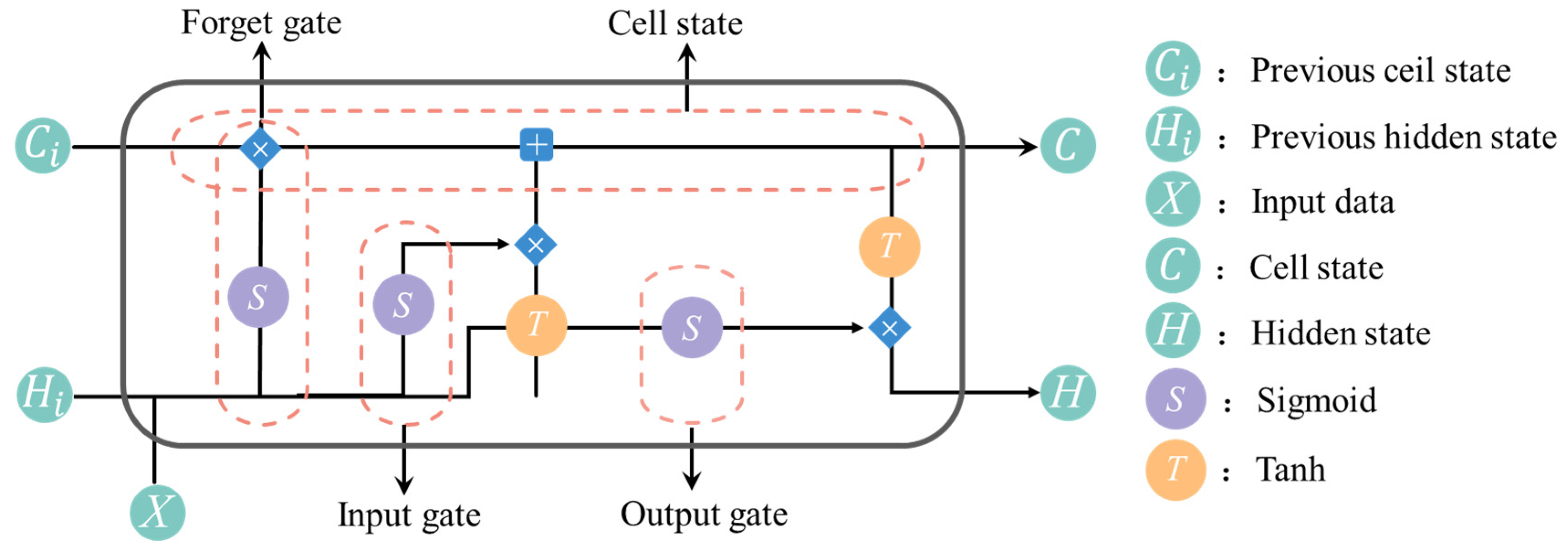
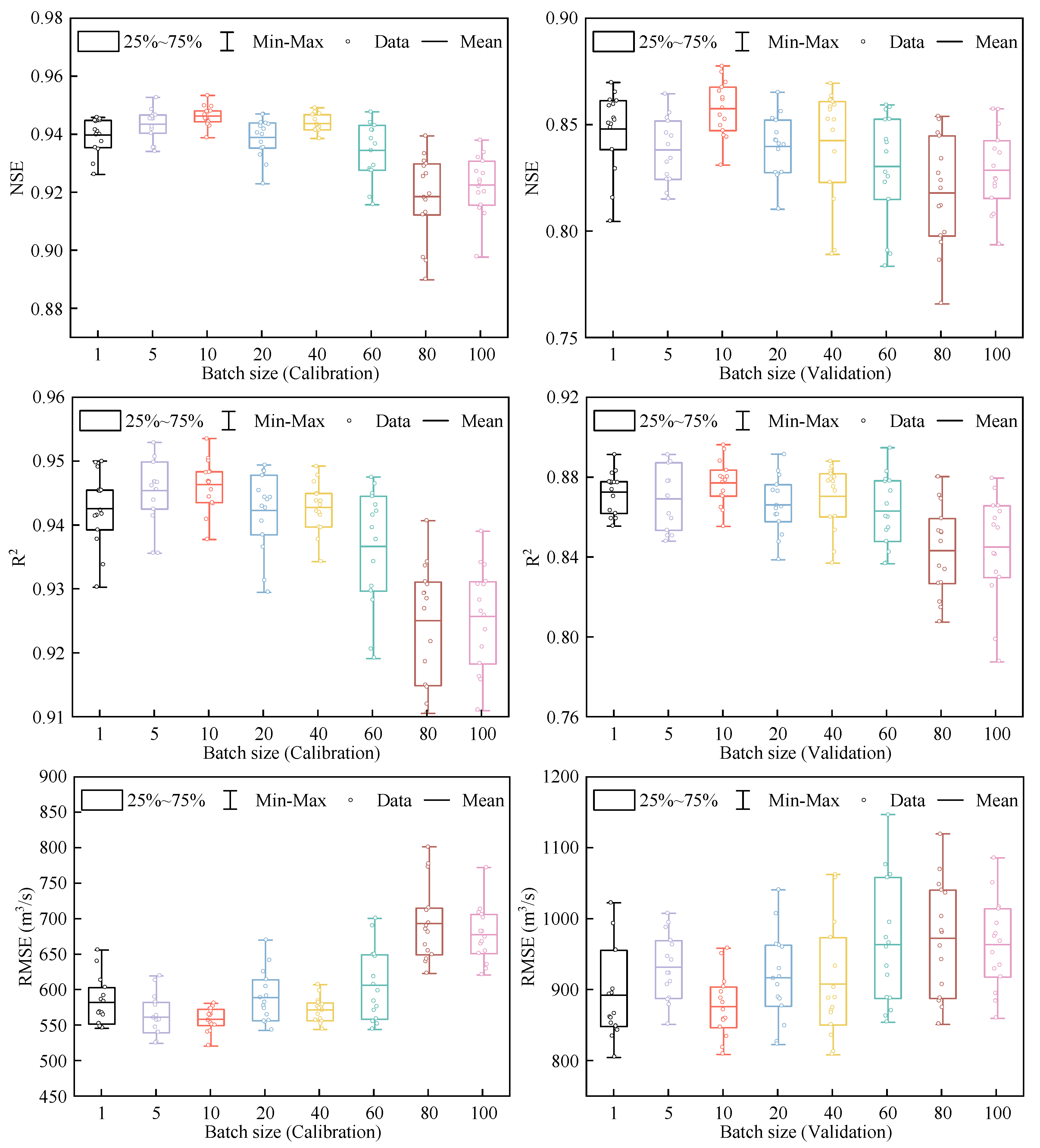
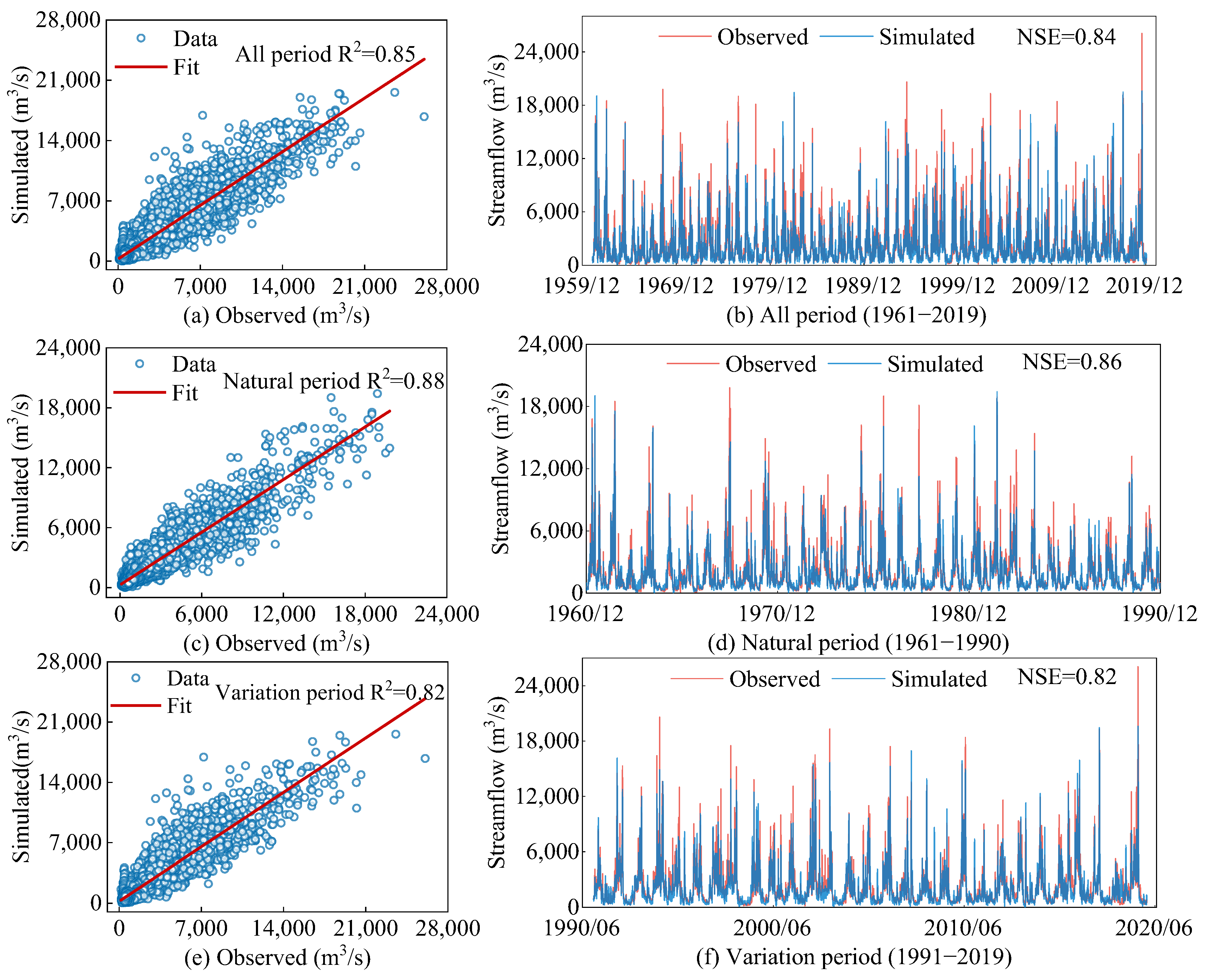
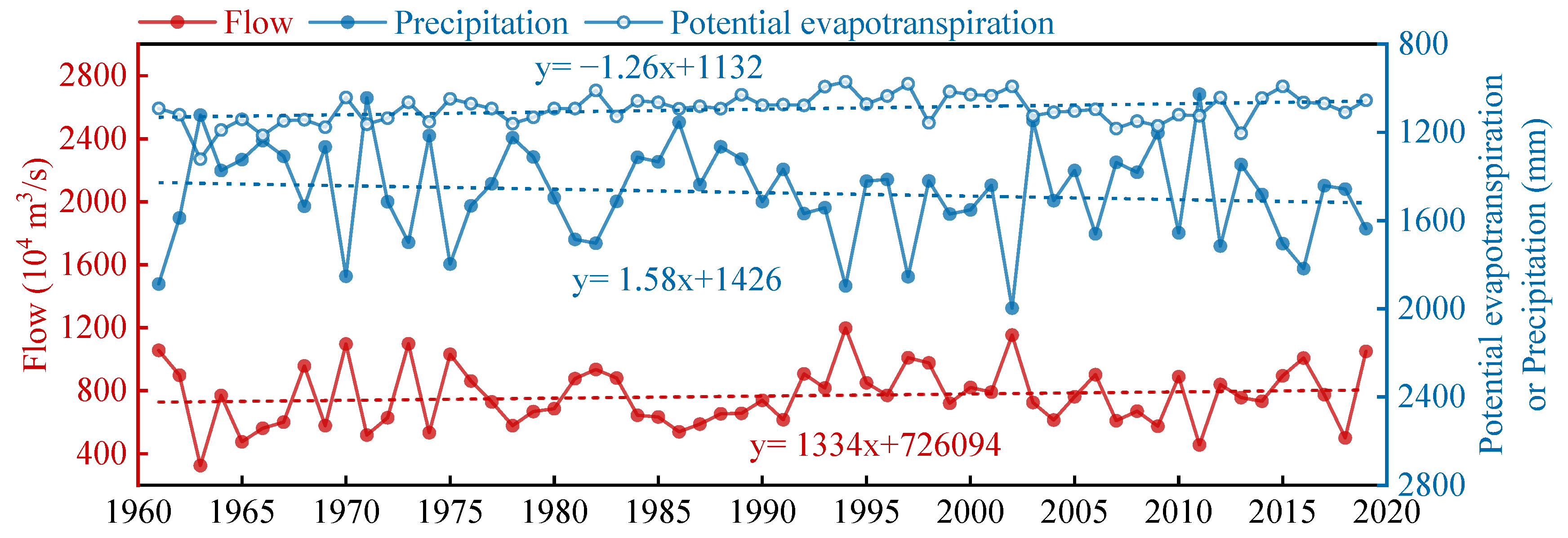

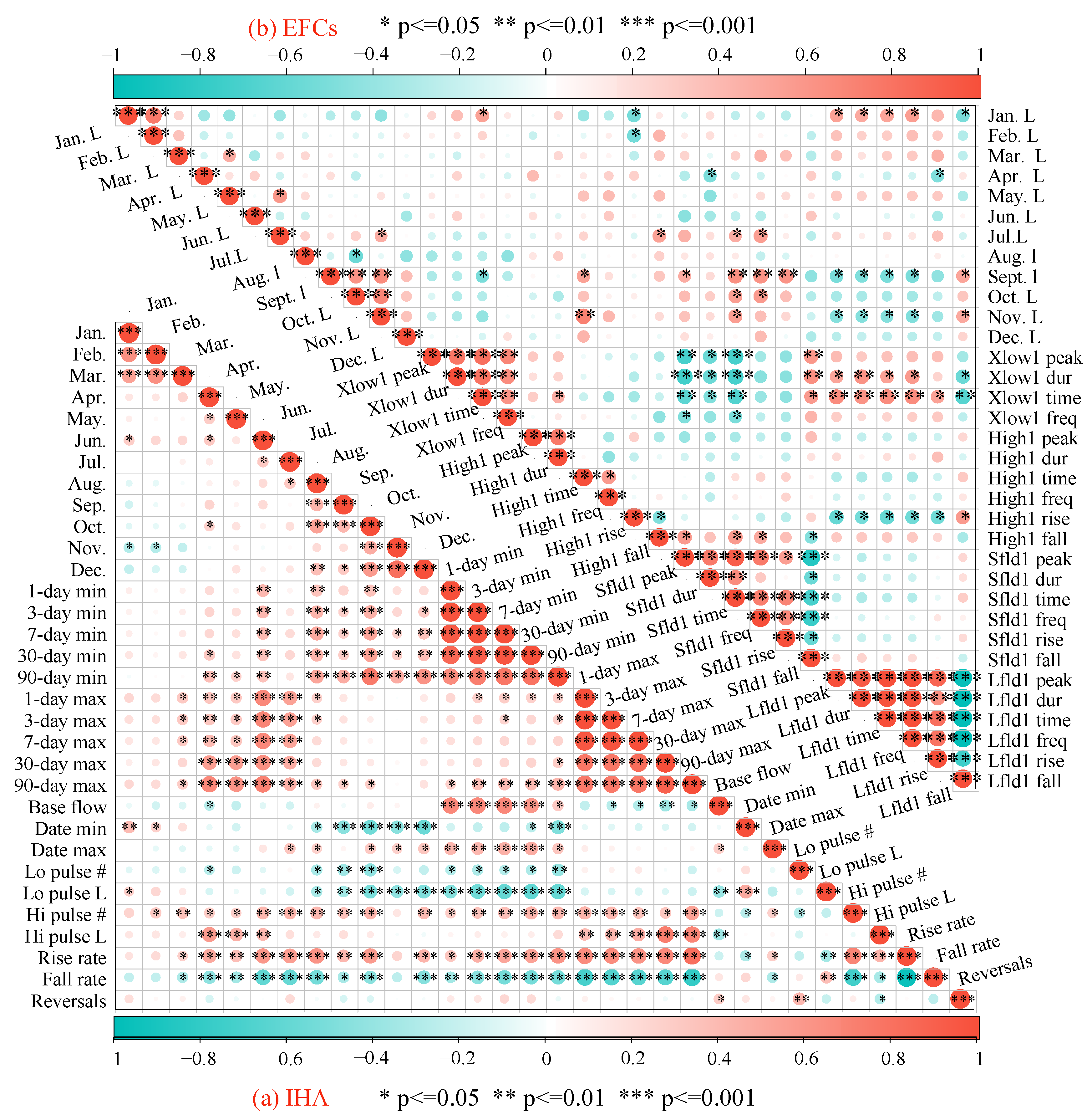


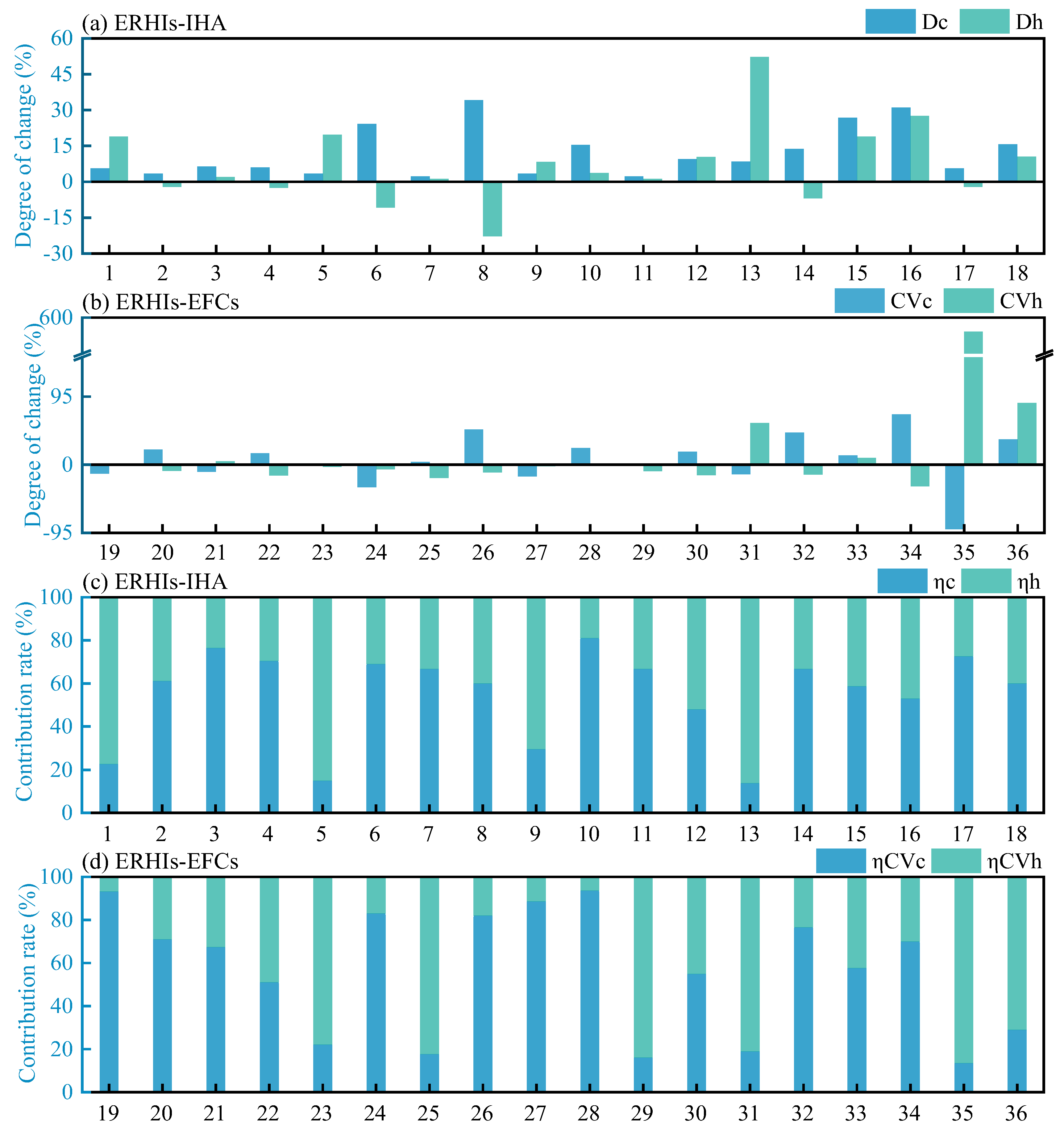
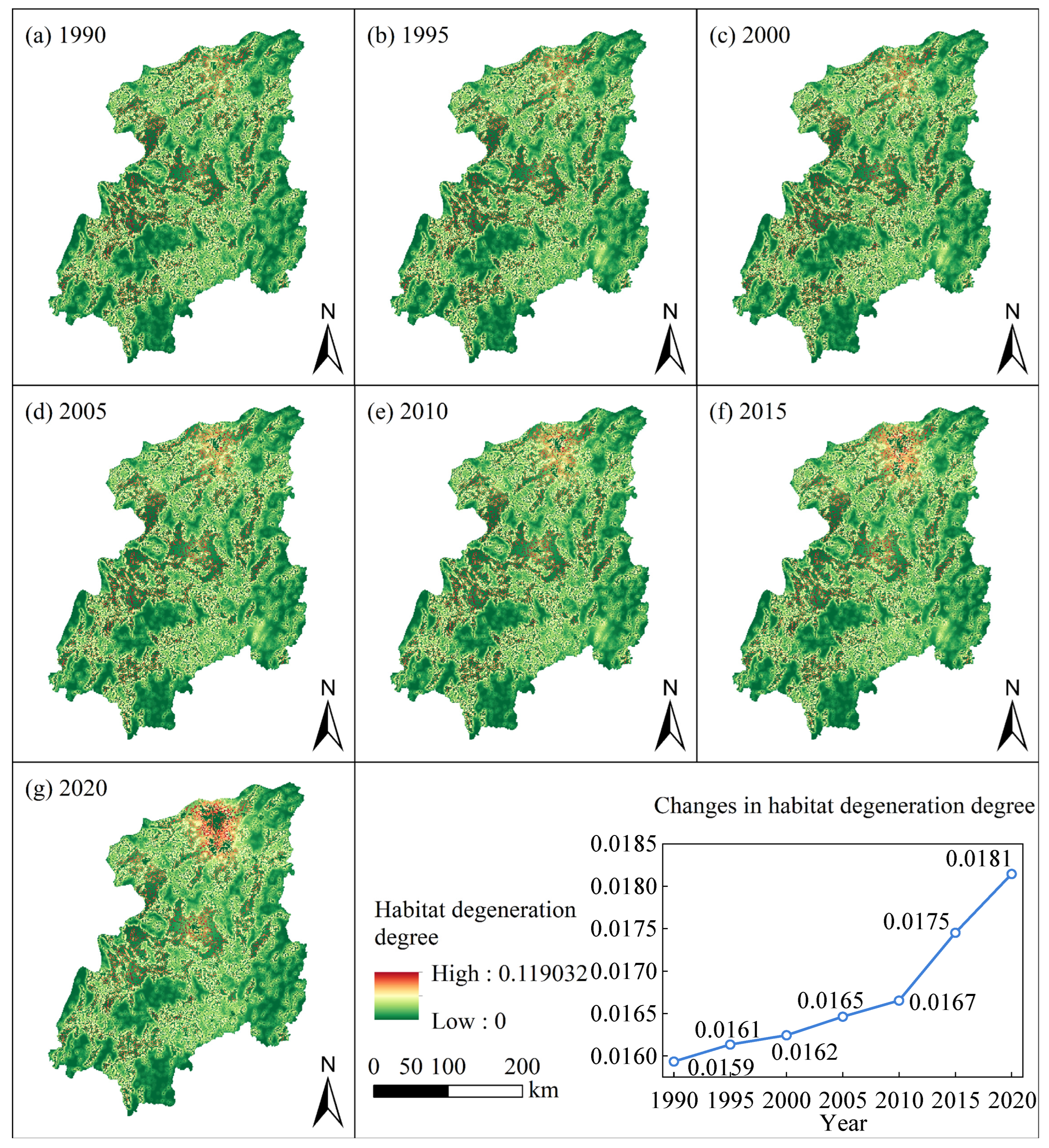
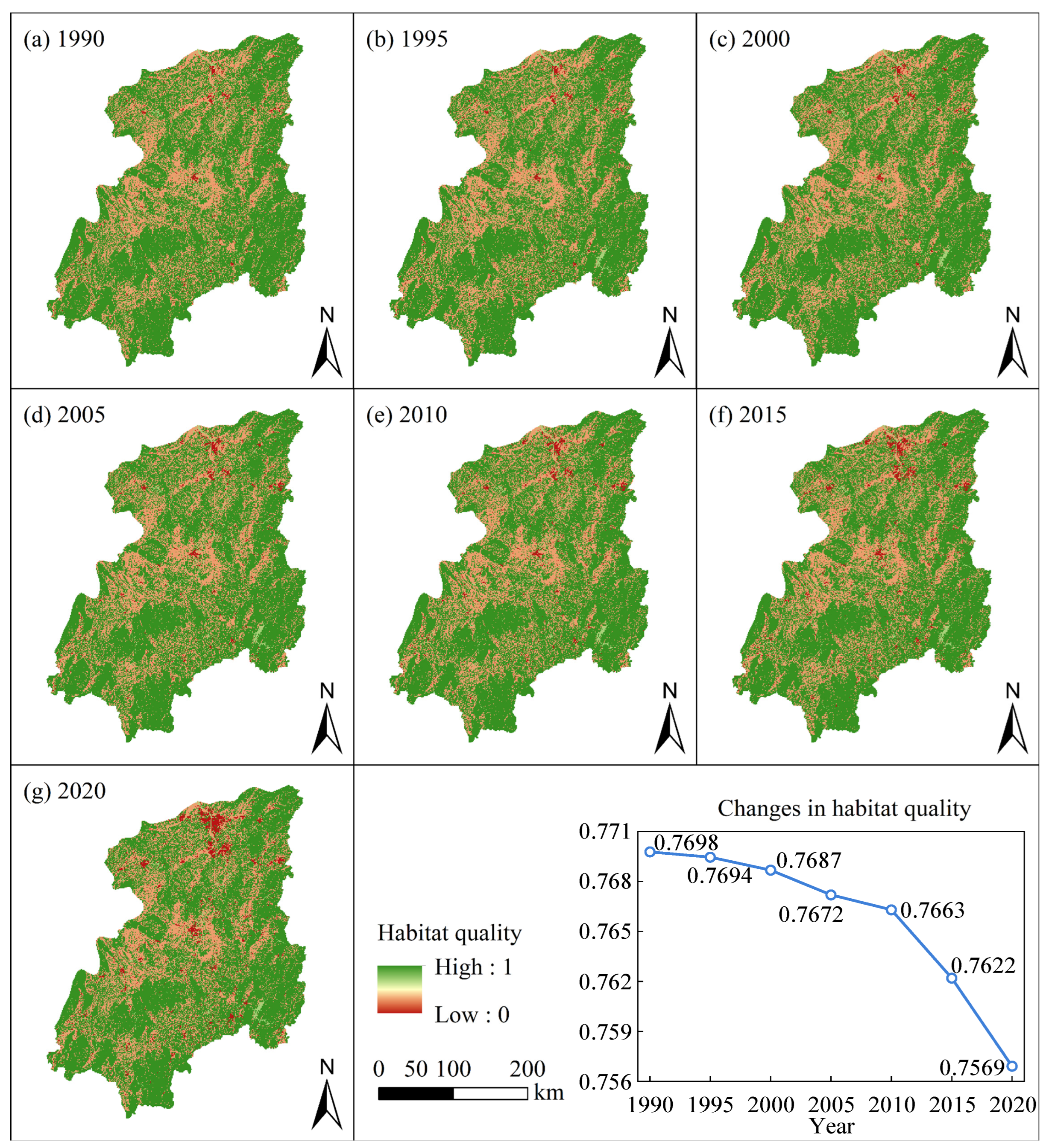
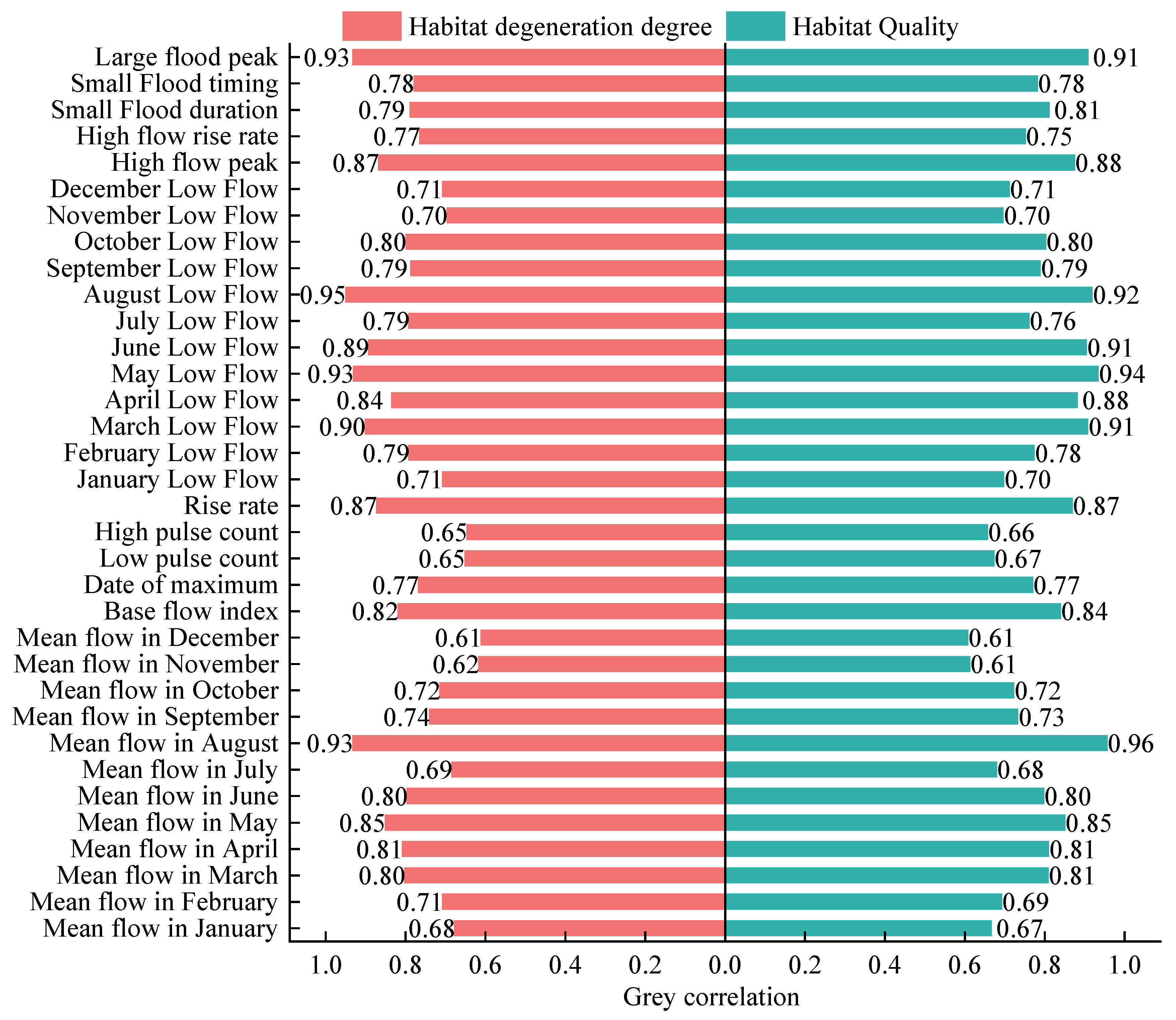
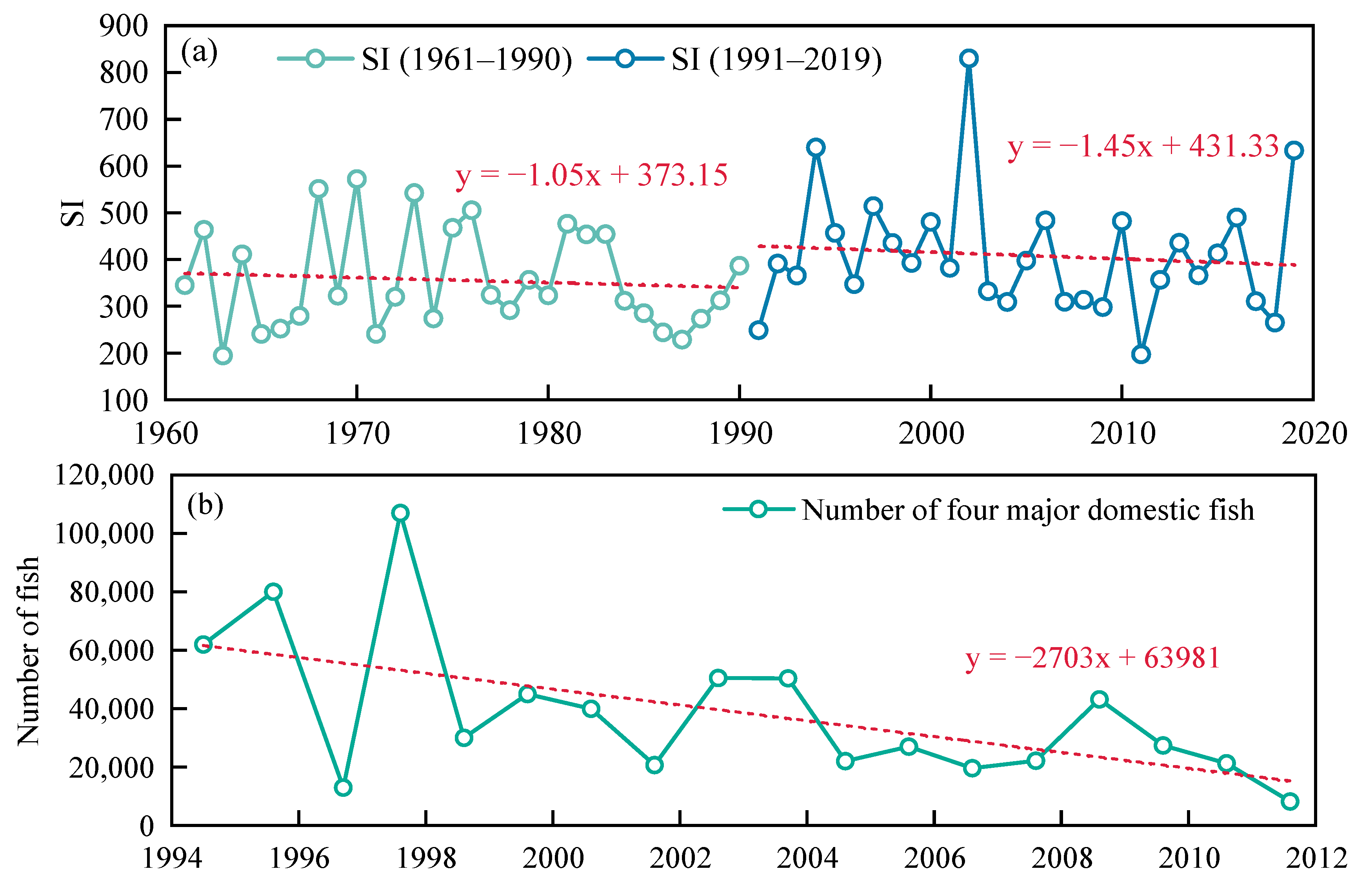
| Station | Station Type | Control Area (km2) | Altitude (m) | Longitude (E) | Latitude (N) |
|---|---|---|---|---|---|
| Xiangtan | Hydrological station | 81,600.00 | 63.80 | 112.93 | 27.87 |
| Chenzhou | 10,601.17 | 368.80 | 112.97 | 25.73 | |
| Shuangfeng | 11,905.68 | 100.00 | 112.17 | 27.45 | |
| Yongzhou | 12,826.50 | 172.60 | 111.62 | 26.23 | |
| Daoxian | Meteorological station | 16,456.87 | 192.00 | 111.60 | 25.53 |
| Zhuzhou | 16,444.20 | 74.60 | 113.17 | 27.87 | |
| Guidong | 6170.81 | 835.90 | 113.95 | 26.00 | |
| Hengyang | 9593.82 | 104.90 | 112.60 | 26.88 | |
| Youxian | 10,166.43 | 115.20 | 113.35 | 27.00 |
| Type of Parameters | Parameter Name | Setting |
|---|---|---|
| Hyper parameters | Dropout rate | 40 |
| Initial learning rate | 0.02 | |
| Epoch | 150 | |
| Batch size | 10 | |
| Layers | 5 | |
| Dropout period | 40 | |
| Hidden size | 150 | |
| Common parameters | Training hardware | CPU |
| Gradient threshold | 1 | |
| Network solving algorithm | adam |
| Habitat Threat Factors | Maximum Impact Distance (km) | Weight | Recession Correlation |
|---|---|---|---|
| Agricultural land | 4 | 0.6 | Linear |
| Rural land | 5 | 0.6 | Exponential |
| Urban land | 10 | 1.0 | Exponential |
| Industrial mining | 12 | 1.0 | Exponential |
| Reservoir/Pond | 6 | 0.6 | Exponential |
| Land-Use Type | Habitat Suitability | Sensitivity | ||||
|---|---|---|---|---|---|---|
| Agricultural Land | Rural Land | Urban Land | Industrial Mining | Reservoir/Pond | ||
| Agricultural land | 0.3 | 0.0 | 0.6 | 0.8 | 0.8 | 0.6 |
| Forest land | 1.0 | 0.6 | 0.4 | 0.6 | 0.7 | 0.5 |
| Grass land | 1.0 | 0.8 | 0.5 | 0.4 | 0.6 | 0.6 |
| Water body | 0.7 | 0.5 | 0.3 | 0.7 | 0.5 | 0.7 |
| Built-up land | 0.0 | 0.0 | 0.0 | 0.0 | 0.0 | 0.4 |
| Unused land | 0.4 | 0.3 | 0.1 | 0.1 | 0.3 | 0.4 |
| Study Area | Flow | Precipitation | Potential Evapotranspiration | |||
|---|---|---|---|---|---|---|
| Z | Trend | Z | Trend | Z | Trend | |
| Xiangjiang River basin | 1.11 | Rise | 1.23 | Rise | −2.41 * | Decline |
| ERHIs-IHA (label) | Measured average values | Measured thresholds | Degree of change (%) | |||
| 1961–1990 | 1991–2019 | Low | High | Obs | Sim | |
| Mean flow in January (1) | 829 | 1298 | 297 | 1361 | 24.4 | 5.55 |
| Mean flow in February (2) | 1357 | 1559 | 680 | 2034 | 1.25 | 3.45 |
| Mean flow in March (3) | 2048 | 2527 | 964 | 3131 | 8.37 | 6.40 |
| Mean flow in April (4) | 3855 | 3247 | 2261 | 5449 | 3.45 | 5.96 |
| Mean flow in May (5) | 4312 | 3867 | 2435 | 6189 | 23.15 | 3.45 |
| Mean flow in June (6) | 3788 | 4323 | 1940 | 5636 | 13.3 | 24.14 |
| Mean flow in July (7) | 2128 | 2866 | 9401 | 3710 | 3.45 | 2.30 |
| Mean flow in August (8) | 1451 | 2083 | 759 | 2143 | 11.33 | 34.17 |
| Mean flow in September (9) | 1219 | 1333 | 231 | 2207 | 11.72 | 3.44 |
| Mean flow in October (10) | 984.5 | 1066 | 460 | 1509 | 18.97 | 15.36 |
| Mean flow in November (11) | 1113 | 1223 | 439 | 1788 | 3.448 | 2.29 |
| Mean flow in December (12) | 805.2 | 1099 | 403 | 1379 | 19.78 | 9.48 |
| Base flow index (13) | 0.17 | 0.22 | 0.13 | 0.21 | 60.59 | 8.37 |
| Date of maximum (14) | 156.30 | 182.90 | 121.20 | 191.40 | 6.90 | 13.79 |
| Low pulse count (15) | 5.20 | 5.03 | 3.25 | 7.16 | 45.55 | 26.72 |
| High pulse count (16) | 6.30 | 8.24 | 4.30 | 8.30 | 58.62 | 31.03 |
| Rise rate (17) | 363.50 | 409.60 | 251.00 | 476.00 | 3.45 | 5.55 |
| Overall degree of change (18) | —— | —— | —— | —— | 26.21 | 15.71 |
| ERHIs-IHA (label) | Measured average values | Coefficient of variation | Degree of variation (%) | |||
| 1961–1990 | 1991–2019 | Pre-1991 | Post-1991 | Obs | Sim | |
| January Low Flow (19) | 846 | 1104 | 0.47 | 0.41 | 11.67 | 12.58 |
| February Low Flow (20) | 1136 | 1186 | 0.30 | 0.33 | 12.46 | 21.03 |
| March Low Flow (21) | 1416 | 1641 | 0.28 | 0.27 | 5.15 | 9.95 |
| April Low Flow (22) | 1807 | 1836 | 0.20 | 0.20 | 0.66 | 15.76 |
| May Low Flow (23) | 1870 | 1946 | 0.14 | 0.14 | 3.91 | 0.87 |
| June Low Flow (24) | 1675 | 1942 | 0.22 | 0.14 | 38.03 | 31.59 |
| July Low Flow (25) | 1206 | 1500 | 0.31 | 0.26 | 14.61 | 3.968 |
| August Low Flow (26) | 1096 | 1392 | 0.24 | 0.34 | 38.19 | 48.94 |
| September Low Flow (27) | 1054 | 1152 | 0.39 | 0.32 | 18.45 | 16.35 |
| October Low Flow (28) | 924 | 926 | 0.34 | 0.42 | 21.48 | 23.06 |
| November Low Flow (29) | 1004 | 1026 | 0.45 | 0.40 | 10.54 | 1.70 |
| December Low Flow (30) | 808 | 906 | 0.43 | 0.44 | 3.216 | 17.91 |
| High-flow peak (31) | 4923 | 4711 | 0.17 | 0.24 | 44.41 | 13.53 |
| High flow rise rate (32) | 760 | 781 | 0.29 | 0.38 | 31.12 | 44.88 |
| Small Flood duration (33) | 31 | 39 | 0.60 | 0.74 | 22.63 | 13.06 |
| Small Flood timing (34) | 150 | 181.6 | 0.09 | 0.13 | 40.15 | 70.19 |
| Large flood peak (35) | 19,230 | 21,310 | 0.03 | 0.15 | 490.30 | 90.19 |
| Overall variability (36) | —— | —— | —— | —— | 121.23 | 35.07 |
Disclaimer/Publisher’s Note: The statements, opinions and data contained in all publications are solely those of the individual author(s) and contributor(s) and not of MDPI and/or the editor(s). MDPI and/or the editor(s) disclaim responsibility for any injury to people or property resulting from any ideas, methods, instructions or products referred to in the content. |
© 2023 by the authors. Licensee MDPI, Basel, Switzerland. This article is an open access article distributed under the terms and conditions of the Creative Commons Attribution (CC BY) license (https://creativecommons.org/licenses/by/4.0/).
Share and Cite
Hong, F.; Guo, W.; Wang, H. A Comprehensive Assessment of the Hydrological Evolution and Habitat Quality of the Xiangjiang River Basin. Water 2023, 15, 3626. https://doi.org/10.3390/w15203626
Hong F, Guo W, Wang H. A Comprehensive Assessment of the Hydrological Evolution and Habitat Quality of the Xiangjiang River Basin. Water. 2023; 15(20):3626. https://doi.org/10.3390/w15203626
Chicago/Turabian StyleHong, Fengtian, Wenxian Guo, and Hongxiang Wang. 2023. "A Comprehensive Assessment of the Hydrological Evolution and Habitat Quality of the Xiangjiang River Basin" Water 15, no. 20: 3626. https://doi.org/10.3390/w15203626
APA StyleHong, F., Guo, W., & Wang, H. (2023). A Comprehensive Assessment of the Hydrological Evolution and Habitat Quality of the Xiangjiang River Basin. Water, 15(20), 3626. https://doi.org/10.3390/w15203626






